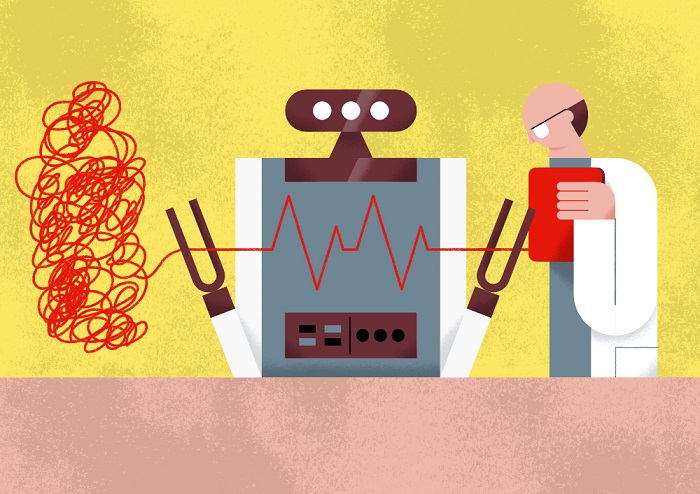Accurate diagnosis, improved workflow, better patient outcomes, and reduced administrative burden on physicians—medical-grade algorithms in cardiology are demonstrating promising results. AI-based ECG analysis enables doctors and healthcare managers to address various priority objectives. Precision is only a tiny part of the story.
Searching for abnormalities in the components of ECG signals is the bread and butter of cardiologists. Translating the language of the heart’s electrical activity recorded in the QRS complex, PR and ST segments, PR and QT interval and T wave into a diagnosis takes a long time. The metrics of heart diseases have been well studied and are thoroughly described in the medical literature. ECG devices are widely used in healthcare facilities and, due to progressive miniaturization, in telemedicine solutions for remote health monitoring.
Hundreds of millions of ECGs are recorded yearly. If they were analyzed automatically by AI systems, we could save hundreds of thousands of doctors’ working hours and take cardiology to the next level. Life sciences still haven’t harnessed all of the opportunities offered by capturing and interpreting voltage graphs. Arrhythmias, coronary health diseases, heart attacks, cardiomyopathies and many other conditions can now be diagnosed even earlier on a large scale and prevented—therefore, it’s a good time to declassify heart disease as one of the leading causes of death.
Automation in harmonized workflows
Machine learning algorithms trained with millions of datasets have the ability to interpret ECG signals with similar precision to a human doctor. As with all medical devices, AI also utilizes human-generated knowledge—literally the historical evaluations made by cardiologists—to recognize specific patterns written in data. In this process, data engineers are like teachers who train the algorithms using a doctor’s experience and expertise.
Automation isn’t about giving machines complete anatomy. Instead, it involves incorporating a new device into medical practice to ensure patient safety, improve access to diagnosis and care services, and upgrade precision and efficiency. With a second pair of eyes, meaning the AI algorithms, doctors gain more certainty, regardless of time pressure or stress in the work environment. This new workflow can then be used to meet the individual healthcare provider’s goals. Before now, when resource constraints occurred, medical facilities could either choose to increase quality or decrease costs, assuming the number of patients stayed the same. With AI, this dilemma becomes obsolete—seemingly opposing objectives may be achieved in parallel. Higher cost-effectiveness no longer excludes improved patient experience.
There are many examples demonstrating how hospitals are harnessing AI to improve different metrics. For instance, cardiovascular medicine departments in the Mayo Clinic use AI-guided ECGs to detect faulty health rhythms before any symptoms are evident. AI systems can read a simple test, detect a heart condition and predict possible future problems. The Mayo Clinic’s experience highlights the fact that the application of algorithms may be coupled with a culture of cooperation among medical doctors, engineers, and scientists [1].
Digital precision in a highly demanding ecosystem
It takes around ten years of education to become a cardiologist, including a few years of medical school, internal medicine residency, and cardiology fellowship. Medical doctors are considered to belong to the most respected profession in the world and also a demanding one which requires long working hours, being permanently on call, making complex decisions and carrying out intricate procedures. The emotional toll and levels of stress are high. The responsibility is enormous. According to the Medscape Malpractice Report 2019 [2], 60 percent of cardiologists are named in a malpractice lawsuit at least once in their careers.
We all know that patients respect their doctors, not for their administrative skills but rather for their empathy, expertise and helpfulness. A precise and quick diagnosis is fundamental for a credible patient-doctor relationship. However, from the patient’s perspective, the physician should ensure that the diagnosis is consistent with current medical knowledge and best practice. By implementing AI solutions for ECG analysis, cardiologists gain assistance indouble-checking or making an initial ECG interpretation. Every improvement in precision matters in a complex working ecosystem, whether the goal is to improve care standards, eliminate diagnosis bottlenecks, or introduce a tool to facilitate decision-making.
The relationship between structured data, cooperation, and patient journey
In order to ensure trusted and reliable outcomes in ECG analysis, AI algorithms are entering clinical practice in the cardiovascular departments of hospitals and clinics. It’s as simple as it sounds: take the 7-day or 24-hour Holter ECG data from any device and upload it to the Cardiomatics cloud AI platform to obtain a detailed report without burdening professionals, who can then focus on other tasks. Automation means that Holter ECG data becomes more accessible, even in routine screenings or studies investigating cardiac health and risk factors for cardiovascular diseases. The results may be used to contribute to new advances in medicine and thus, a better prevention of CVDs. This perspective of Artificial intelligence as an enabler of better research or as a workflow management tool should be considered in every healthcare system, hospital and clinic, and also by every doctor working within these institutions. It’s the user who determines an algorithm’s objective—the scope of possible results is far broader than just simple ECG interpretation for better precision.
“Quality of care” and “patient journey” are the no. 1 topics being discussed by policymakers. Secure, accurate, validated, medical-grade algorithms may enhance the way in which care is streamlined, quality is controlled and the physician’s work is organized. Significant change starts with innovation at the elementary level of healthcare. Artificial intelligence is already a valuable asset in clinical practice and the number of studies that confirm this is growing.
Sources:
[1] Mayoclinic.org
[2] Medscape.com

